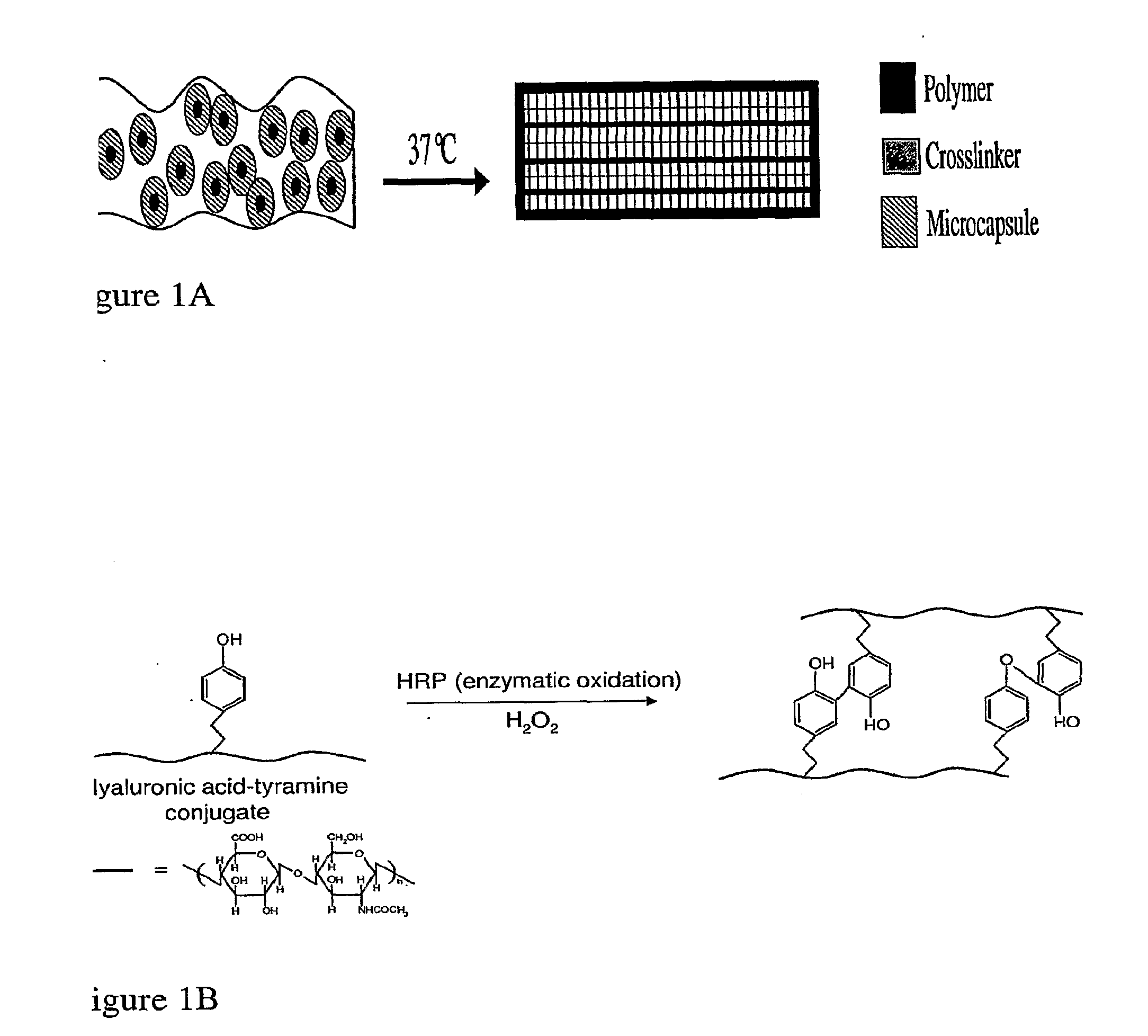Thermo-responsive materials
a technology of thermoresponsive materials and lipids, applied in the field ofmatrices, can solve the problems of inadequate replacement of biological functions, immunological rejection, and several limitations in the development of appropriate scaffolds, and achieve the effect of increasing the permeabil reassuring the fluidity of said liposom
- Summary
- Abstract
- Description
- Claims
- Application Information
AI Technical Summary
Benefits of technology
Problems solved by technology
Method used
Image
Examples
example 1
Thermally Triggered Cross-linker Release from Liposomes as a Basis for Scaffold Design
[0180]In order to provide a biocompatible, injectable scaffolding system, the encapsulation of a cross-linker, or active species, was conducted within thermoresponsive liposomes (FIG. 1). At room temperature, the construct remains a liquid due to the separation of the polymer and cross-linker. At body temperature, the cross-linker is released, resulting in solidification and scaffold formation. Liposomes are biocompatible, versatile encapsulating agents that have been studied extensively for drug and gene delivery. They are also known to experience a gel-to-liquid phase transition at a given temperature, where the membrane permeability is significantly enhanced. We have, therefore, chosen liposomes for the thermally triggered release of crosslinkers. By segregating the crosslinker from the polymer, determinants of working time and mechanical strength can be separately controlled. The working time d...
example 2
Effect of Material Parameters on Total HRP Release
[0183]To minimize enzyme deactivation and avoid the heat and organic solvents involved in general liposome synthesis procedures, a DRV method, as described, was chosen to encapsulate HRP. This method involved the synthesis of blank single unilamellar vesicles (SUV's), with which an HRP solution was mixed. The liposome / enzyme solution was then freeze-dried, during which the vesicles fused and thus encapsulated the enzymes. Upon rehydration, liposomes containing HRP within the aqueous core were then formed. Following this technique, HRP remained encapsulated within the liposome at 25° C., and was released rapidly at 37° C. (FIG. 2).
[0184]In order to create liposomes which may be thermally triggered at body temperature, dipalmitoyl-phosphatidylcholine (DPPC) and dimyristoylphosphatidylcholine (DMPC) were used. These phospholipids have phase transition temperatures of 41° C. and 23° C., respectively, and may be blended to give an overall...
example 3
Effect of Processing Parameters on Total HRP Release
[0186]Due to the sensitivity of the enzyme to deactivation, the processing parameters were found to be critical in determining total HRP release. Increased lipid concentration increased HRP entrapment (FIG. 5A), since the contact between the EHP and lipid vesicles increased. During dehydration, an increase in lipid concentration increased the probability of contact between HRP molecules and lipid sheets, thereby increasing total encapsulation during vesicle fusion.
[0187]Freezing stresses can lead to significant denaturation of the protein during liposome synthesis. FIG. 5B shows that the means by which the enzymelliposome solutions are frozen, which determines the rate of cooling, is important in determining the enzymatic activity recovered. The slower the freezing rate, the less the enzyme is damaged in the course of synthesis.
[0188]In freeze-drying proteins alone, it has been found that the addition of a cryoprotectant, such as t...
PUM
| Property | Measurement | Unit |
|---|---|---|
| Temperature | aaaaa | aaaaa |
| Fraction | aaaaa | aaaaa |
| Fraction | aaaaa | aaaaa |
Abstract
Description
Claims
Application Information
 Login to View More
Login to View More - R&D
- Intellectual Property
- Life Sciences
- Materials
- Tech Scout
- Unparalleled Data Quality
- Higher Quality Content
- 60% Fewer Hallucinations
Browse by: Latest US Patents, China's latest patents, Technical Efficacy Thesaurus, Application Domain, Technology Topic, Popular Technical Reports.
© 2025 PatSnap. All rights reserved.Legal|Privacy policy|Modern Slavery Act Transparency Statement|Sitemap|About US| Contact US: help@patsnap.com



